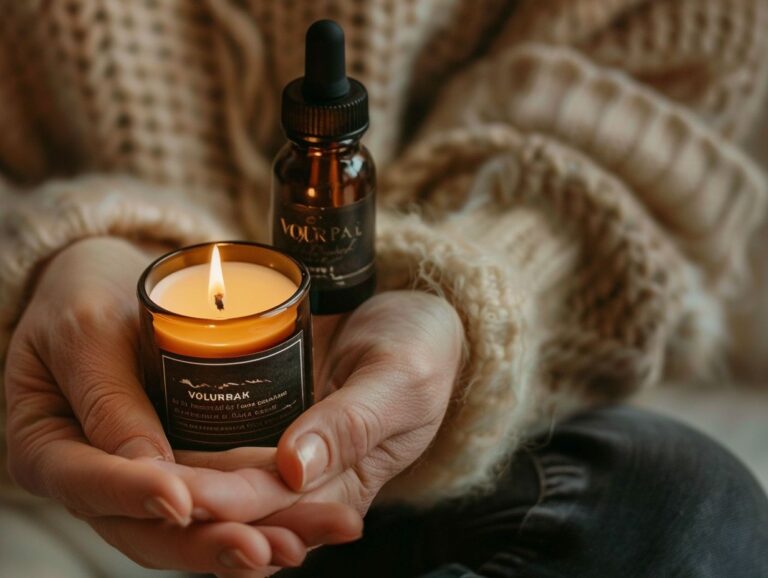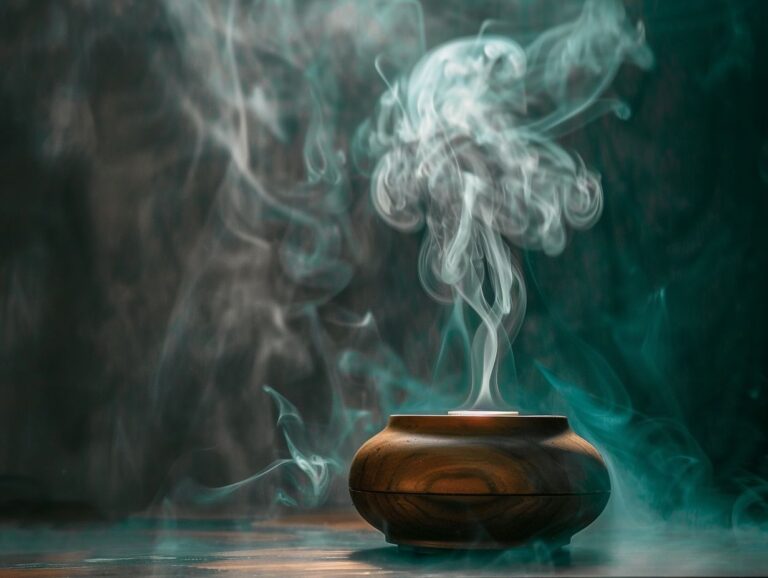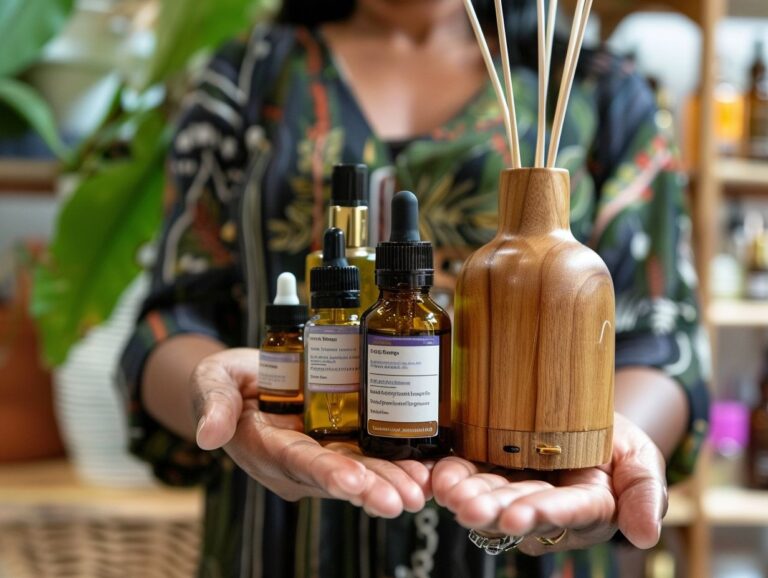Where to Apply Essential Oils for Lymph Drainage
Have you ever heard of lymph drainage and essential oils? If not, you’re in for a treat.
We’ll explore what lymph drainage is, how it works, and the benefits of using essential oils for this purpose.
We’ll also discuss where to apply essential oils for lymph drainage and the potential risks or side effects to be aware of.
Sit back, relax, and let’s dive into the world of lymphatic health and essential oils.
Key Takeaways:
What is Lymph Drainage?
Lymph drainage is a therapeutic technique that utilizes essential oils and massage to stimulate the lymphatic system, promoting circulation and lymphatic function.
This gentle technique aids in the removal of toxins and waste from the body, helping to reduce swelling and inflammation. Essential oils are often chosen for their specific properties that can enhance the detoxification process and support overall well-being. The massage applied during lymph drainage helps to encourage the natural flow of lymph fluid, which plays a crucial role in immune function.
By promoting the movement of lymphatic fluid, lymph drainage can enhance the body’s ability to fight off infections and illness. It can also help to improve overall circulation, reduce water retention, and promote relaxation. Individuals seeking to boost their lymphatic system’s efficiency often turn to lymph drainage as a natural and holistic approach to wellness.
How Does Lymph Drainage Work?
Lymph drainage works by targeting the lymphatic system, facilitating the movement of lymph fluid through the body using specialized techniques such as massage and the application of essential oils.
This process aids in lymph movement by stimulating the contraction of lymphatic vessels, increasing the flow of lymph toward the lymph nodes, where impurities and waste products are filtered out. It also helps maintain proper circulation of lymph, enhancing immune functions and reducing swelling caused by fluid retention. The application of essential oils during lymphatic drainage can further support these processes by promoting relaxation, reducing inflammation, and boosting lymphatic system performance.
What is the Lymphatic System?
The lymphatic system is a vital network of lymph nodes, vessels, and organs that play a crucial role in supporting the immune system by filtering lymph fluid and removing toxins from the body.
It acts as a drainage system for the body, collecting excess fluid from tissues and returning it to the bloodstream while also transporting white blood cells to fight infection. The lymphatic vessels, similar to blood vessels, carry lymph fluid rich in immune cells throughout the body. At the core of this intricate system are the lymph nodes, which act as checkpoints that trap and neutralize foreign invaders like bacteria and viruses.
What is the Purpose of Lymph Drainage?
The purpose of lymph drainage is to optimize lymphatic function, promote lymph support, and enhance the flow of lymphatic fluid through gentle massage techniques and the application of essential oils.
By utilizing specialized maneuvers that target the lymphatic system, lymph drainage seeks to facilitate the removal of toxins, waste, and excess fluid from the body. This process aids in boosting the immune system, reducing inflammation, and promoting overall well-being.
The incorporation of essential oils in lymphatic drainage sessions can enhance the therapeutic benefits by providing calming, anti-inflammatory, and detoxifying properties. These oils are carefully selected to complement the massage techniques and further support the body’s natural healing processes.
What are Essential Oils?
Essential oils are natural aromatic compounds derived from plants that are commonly used in lymph drainage to provide lymphatic support and enhance the therapeutic effects of massage.
These oils have been utilized for centuries in various forms of healing practices, owing to their potent medicinal properties.
-
Essential oils are extracted through processes like distillation or cold pressing, capturing the plant’s essence and fragrance.
-
The benefits of essential oils range from promoting relaxation and stress relief to boosting immunity and reducing inflammation.
-
When incorporated into lymph drainage techniques, these oils help facilitate the movement of lymphatic fluid, aiding in detoxification and promoting overall well-being.
How are Essential Oils Used for Lymph Drainage?
Essential oils are used for lymph drainage by blending them into massage oils or creams, which are applied to specific areas to target the lymphatic system and enhance the therapeutic benefits of the massage.
Creating customized essential oil blends for lymphatic drainage can be a tailored and effective approach in the realm of massage therapy. These blends combine carefully selected essential oils known for their lymphatic support properties, such as juniper berry, grapefruit, and cypress.
The benefits of essential oils in lymphatic drainage include promoting circulation, reducing inflammation, and aiding in detoxification processes within the body. When applied during a lymphatic drainage massage, these oils can facilitate the movement of lymph fluid and help in clearing congestion in the lymphatic system.
Where to Apply Essential Oils for Lymph Drainage?

In terms of lymphatic drainage, it’s crucial to focus on specific regions of the body where the lymphatic system is most active. Essential oils can be applied to the neck area, gently massaging them in to stimulate lymph flow. The abdomen is another vital region where lymphatic drainage can be facilitated using essential oils through gentle circular motions. For overall lymphatic support, incorporating essential oils in massage therapy techniques can provide a holistic approach to promoting a healthy lymphatic system.
Neck and Throat
Applying essential oils to the neck and throat area can help target lymph nodes and promote lymphatic drainage through gentle massage techniques.
When using essential oils for lymphatic drainage, it is important to dilute them properly with a carrier oil before applying directly to the skin. This allows for a safer and more effective application, reducing the risk of skin irritation. By gently massaging the oils into the neck and throat, you can stimulate the lymph nodes and encourage the flow of lymphatic fluid, aiding in detoxification and immune support.
The aromatic properties of essential oils can have a soothing effect on the mind and body, enhancing the overall relaxation and wellness benefits of the massage. The combination of targeted application, massage, and aromatherapy makes this practice a holistic approach to supporting lymphatic health and overall well-being.
Underarms
The underarms are a crucial area for applying essential oils in lymph drainage to stimulate lymph nodes and support the natural flow of lymphatic fluid.
The lymphatic system plays a vital role in the body’s immune defense and overall health, as it helps in filtering out toxins and waste. Using essential oils in the underarm area can help enhance lymphatic function by promoting circulation and detoxification.
Targeted massage with these oils can aid in reducing inflammation, swelling, and blockages in the lymph nodes, thus facilitating better lymph flow throughout the body.
It is essential to choose the right essential oils known for their properties in aiding lymphatic drainage, such as lemon, cypress, or frankincense, to maximize the benefits of this therapeutic practice.
Abdomen
Targeting the abdomen with essential oils during lymph drainage can aid in supporting the lymphatic system and improving digestive functions through massage techniques.
When essential oils are applied on the abdomen, they can penetrate the skin and enter the bloodstream, where their therapeutic properties can positively impact the flow of lymph fluid in the body.
Lymph drainage massage combined with the use of essential oils helps to stimulate lymph circulation, remove toxins, and reduce inflammation, thus promoting overall wellness.
Groin Area
Applying essential oils to the groin area in lymph drainage can help support lymphatic circulation and alleviate tension through targeted massage techniques.
When using essential oils for lymphatic support in the groin region, it’s crucial to understand that the lymphatic system plays a vital role in maintaining the body’s immune responses and fluid balance. By incorporating the right essential oils, such as lemongrass or ginger, one can enhance the effectiveness of lymph drainage massages.
The relaxing scent of these oils can help create a calming atmosphere during the massage, promoting overall relaxation and stress relief. This dual benefit of physical and mental relaxation can greatly improve the effectiveness of the lymph drainage process.
Feet and Ankles
The feet and ankles are key areas for applying essential oils during lymph drainage to promote lymph flow, improve circulation, and enhance relaxation through massage techniques.
When essential oils are applied to the feet and ankles, they are absorbed through the skin and reach the lymphatic system, where their therapeutic properties come into play. These oils are known for their anti-inflammatory and detoxifying effects, making them ideal for supporting the body’s natural cleansing process. By aiding in the movement of lymph fluid, essential oils facilitate the removal of toxins and waste products, bolstering the immune system and reducing swelling.
Hands and Wrists
Applying essential oils to the hands and wrists in lymph drainage can help support the lymphatic system and improve hand circulation through targeted massage techniques.
When applying essential oils for lymph drainage on the hands and wrists, it’s crucial to start by choosing the right essential oil blend known for its lymphatic support properties such as cypress or rosemary.
Begin by diluting a few drops of the oil with a carrier oil like almond or coconut oil. Gently massage the blend onto the back of the hands and wrists, following the lymphatic pathways towards the heart to enhance lymphatic circulation and reduce swelling. This method not only promotes lymphatic drainage but also provides a soothing and calming effect through the aromatic benefits of the essential oils.
Behind the Knees

Applying essential oils behind the knees provides a dual benefit by facilitating lymphatic drainage and promoting relaxation. The gentle massage techniques help enhance blood flow and reduce swelling in the affected areas. The anti-inflammatory properties of certain essential oils can further assist in combating fluid retention and easing discomfort.
Essential oils such as lavender and peppermint are popular choices due to their calming and cooling effects on the skin. The aroma of these oils can also contribute to a soothing ambiance, enhancing the overall experience of the massage therapy.
Lower Back
Applying essential oils to the lower back area during lymph drainage can help support lymphatic function, promote relaxation, and alleviate discomfort through targeted massage techniques.
When essential oils are applied to the lower back, the lymphatic system is stimulated, which can help in the removal of toxins and waste products from the body. This gentle method of aiding lymph drainage through the use of aromatic oils not only benefits physical health but also aids in mental relaxation. The soothing scents of oils like lavender or chamomile can enhance the overall massage therapy experience, creating a calming atmosphere.
What are the Benefits of Using Essential Oils for Lymph Drainage?
Using essential oils for lymph drainage offers numerous benefits, including reducing swelling and inflammation, improving immune system function, promoting relaxation, and aiding in detoxification.
When these essential oils are applied topically or used in aromatherapy, they can stimulate lymph nodes to release toxins, clear blockages, and improve circulation. This, in turn, enhances the immune support by boosting the body’s natural defense mechanisms.
The soothing aroma of certain essential oils, such as lavender or chamomile, can provide much-needed stress relief and relaxation, helping to calm both the mind and the body. The purifying properties of oils like lemon or grapefruit further aid in the detox processes, assisting the body in eliminating harmful substances and promoting overall well-being.
Reduces Swelling and Inflammation
The use of essential oils in lymph drainage can effectively reduce swelling and inflammation, with oils like grapefruit, geranium, and cypress known for their anti-inflammatory properties.
These essential oils play a crucial role in promoting lymphatic flow, aiding in the body’s natural detoxification process. Geranium oil, in particular, is celebrated for its ability to reduce fluid retention and promote circulation.
Grapefruit oil not only helps reduce swelling but also boosts energy levels and uplifts the mood due to its invigorating aroma.
On the other hand, cypress oil is valued for its calming effect on the lymphatic system, promoting a sense of balance and harmony.
Improves Immune System Function
The application of essential oils for lymph drainage can enhance immune system function, with oils like ginger, frankincense, and peppermint known for their immune-boosting properties.
These oils contain potent antiviral, antibacterial, and anti-inflammatory properties that play a vital role in supporting the immune system’s response to infections and illnesses.
Ginger, with its warming effects, aids in increasing circulation and promoting detoxification in the lymphatic system, thus boosting immunity.
Frankincense is renowned for its ability to reduce inflammation and strengthen the body’s defense mechanisms.
Peppermint, known for its invigorating scent, helps to clear respiratory pathways and improve overall immune function.
Incorporating these oils into a lymphatic massage routine can not only facilitate lymph drainage and toxin removal but also provide a natural way to enhance immune resilience.
Promotes Relaxation and Stress Relief
Essential oils used in lymph drainage are effective in promoting relaxation and stress relief, with oils like lemon, rosemary, and grapefruit known for their calming properties.
These essential oils play a vital role in creating a tranquil atmosphere during lymphatic drainage sessions. The refreshing scent of lemon revitalizes the mind, while rosemary’s earthy aroma promotes mental clarity and relaxation. Grapefruit’s citrusy notes uplift the spirits, making it a perfect choice to ease tension and anxiety.
Aromatherapy, through the use of these oils, not only enhances the lymphatic flow but also calms the nervous system, reducing stress levels and promoting a sense of well-being. The gentle application of these oils during lymph drainage therapy adds an extra element of relaxation, making the process even more soothing and rejuvenating.
Aids in Detoxification
Using essential oils in lymph drainage can aid in detoxification processes, with oils like oregano, tea tree, and thieves known for their cleansing properties.
These oils contain powerful properties that can help stimulate the lymphatic system, promoting the removal of toxins and waste from the body.
Oregano oil, for instance, is praised for its antimicrobial and antioxidant qualities, which support the elimination of harmful substances.
Tea tree oil is renowned for its antibacterial and anti-inflammatory attributes, helping with the purification of the lymphatic vessels.
Thieves blend, composed of potent antiviral and immune-boosting oils, aids in detoxification by enhancing the body’s natural defenses.
Are There Any Risks or Side Effects of Using Essential Oils for Lymph Drainage?

When using essential oils for lymph drainage, it is crucial to remember that these potent substances can have effects beyond their intended benefits. Improper usage, such as applying undiluted oils directly to the skin, can lead to irritations, allergies, or even chemical burns.
Therefore, it is highly recommended to always dilute essential oils with a carrier oil before topical application. Performing a sensitivity test by applying a small amount of diluted oil on a patch of skin and observing any adverse reactions is a simple yet effective way to minimize the risk of skin irritations.
Frequently Asked Questions
Where to Apply Essential Oils for Lymph Drainage?
Essential oils are believed to have many health benefits, including aiding in lymph drainage. Here are some frequently asked questions about where to apply essential oils for lymph drainage.
What are the best essential oils for lymph drainage?
Some popular essential oils for lymph drainage include lemon, grapefruit, cypress, and peppermint. These oils are known for their detoxifying and anti-inflammatory properties, which can help stimulate lymph flow.
Where should I apply essential oils for lymph drainage?
Essential oils can be applied topically on the skin, but it’s important to choose the right areas for lymph drainage. The most effective areas to apply essential oils for lymph drainage are the neck, armpits, and groin, as these are where lymph nodes are concentrated.
Can essential oils be used for self-massage during lymph drainage?
Yes, essential oils can be used for self-massage during lymph drainage. Gently massaging the affected areas with essential oils can help promote lymph flow and reduce swelling. Be sure to dilute the oils with a carrier oil before applying them to the skin.
How often should I apply essential oils for lymph drainage?
The frequency of essential oil application for lymph drainage may vary depending on an individual’s condition. It’s recommended to start with 2-3 times a week and gradually increase or decrease based on how your body responds to the treatment.
Is there a specific technique for applying essential oils for lymph drainage?
Yes, there are specific techniques for applying essential oils for lymph drainage. The most common technique is dry brushing, which involves using a natural bristle brush to gently massage the skin in circular motions towards the heart. You can also use a lymphatic drainage massage technique to apply essential oils to the lymph nodes.
Are there any precautions to take when using essential oils for lymph drainage?
While essential oils are generally safe to use, it’s important to take some precautions when using them for lymph drainage. Always dilute essential oils with a carrier oil before applying them to the skin, and do a patch test to check for any allergic reactions. If you have any underlying health conditions or are pregnant, consult a healthcare professional before using essential oils for lymph drainage.







